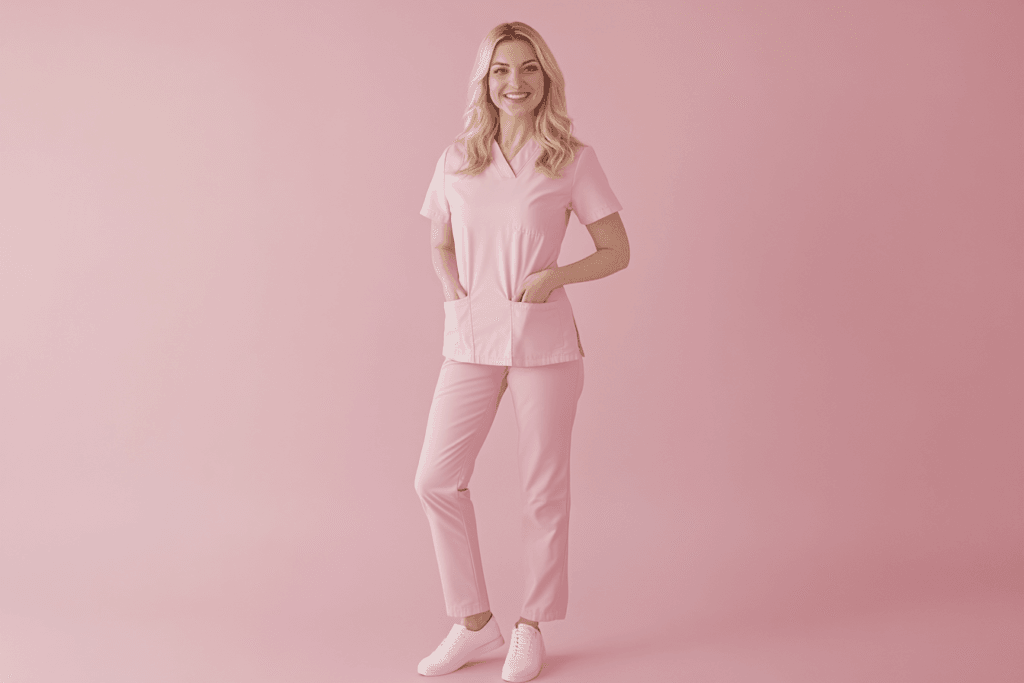
Uniforms made from breathable fabric help you stay comfortable throughout the day. Cotton, linen, and bamboo allow air to circulate freely, reducing heat buildup. Polyester blends, on the other hand, wick sweat away from your skin, keeping you dry. These fabrics not only improve airflow but also adapt to different environments. Whether you work indoors or outside, choosing the right material ensures you feel cool and fresh. By selecting breathable fabric, you also benefit from durability and a professional appearance.
Key Takeaways
- For comfort, choose fabrics like cotton, linen, or bamboo. These materials let air flow and keep you cool.
- Look for fabrics like polyester blends that wick away sweat. They help keep your skin dry during long hours.
- Use lightweight fabrics to allow better air movement. These materials stop heat from building up in hot weather.
- When choosing fabric, consider the weather and your activity. Different places need different materials to keep you comfy.
- Take care of your uniforms by washing in cold water. Let them air dry to keep them breathable and last longer.
What is the Key Characteristics of Breathable Fabrics?
Moisture-wicking and sweat absorption
Breathable fabrics excel at managing moisture, which is essential for staying comfortable during long hours. These fabrics pull sweat away from your skin and allow it to evaporate quickly. This process helps you avoid the sticky feeling that comes with damp clothing. It also reduces the risk of skin irritation caused by trapped moisture.
Fabrics with moisture-wicking properties prevent overheating by keeping your skin dry. This feature is especially important if you work in a physically demanding job or a hot environment. You can stay fresh and focused throughout your day by choosing a breathable fabric with excellent sweat absorption.
- Moisture management improves comfort during extended wear.
- Quick-drying fabrics help regulate body temperature.
- Sweat-wicking materials reduce the chance of skin irritation.
Lightweight and air circulation
The weight of a fabric plays a big role in how breathable it feels. Lightweight materials allow air to flow freely, which helps cool your body. This airflow prevents heat from building up, especially in warm or humid conditions. When your uniform promotes air circulation, you feel less restricted and more at ease.
Breathable fabrics like cotton and linen are naturally light, making them ideal for uniforms. Synthetic blends, such as polyester, are also designed to enhance airflow. Whether you’re working indoors or outdoors, a lightweight fabric ensures you stay comfortable without feeling weighed down.
Temperature regulation for comfort
Breathable fabrics help your body maintain a comfortable temperature. They adapt to your environment by allowing heat to escape when it’s warm and providing insulation when it’s cooler. This balance is crucial for uniforms, ensuring you stay comfortable no matter the weather.
For example, materials like merino wool and bamboo excel at temperature regulation. They keep you warm in cold conditions while remaining breathable enough for warmer climates. Choosing a fabric that regulates temperature effectively allows you to focus on your tasks without being distracted by discomfort.

Which Breathes Better: Natural or Synthetic Fabrics?
When choosing a breathable fabric for uniforms, you’ll encounter natural and synthetic options. Each type offers unique benefits and drawbacks, making it essential to understand how they compare.
Benefits of natural fabrics like cotton, linen, and bamboo
Natural fabrics, such as cotton, linen, and bamboo, are known for their comfort and breathability. These materials allow air to circulate freely, keeping you cool and reducing sweat buildup. Cotton feels soft against your skin, while linen’s lightweight texture makes it perfect for hot climates. Bamboo stands out for its eco-friendly production and antibacterial properties, which help prevent odors.
However, natural fabrics may require more care. They can wrinkle easily and may not last as long as synthetic alternatives. Despite these challenges, their sustainability and comfort make them a popular uniform choice.
Advantages of synthetic options like polyester and nylon
Synthetic fabrics, including polyester and nylon, are designed for durability and performance. These materials resist wear and tear, making them ideal for demanding work environments. They also dry quickly and require minimal maintenance, saving you time and effort.
On the downside, synthetic fabrics are often less breathable than natural ones. They may trap heat, especially in warm conditions. Additionally, their production can have a greater environmental impact. Even so, their strength and convenience make them a practical option for many uniforms.
Why blended fabrics combine the best features
Blended fabrics combine the strengths of natural and synthetic materials. For example, a cotton-polyester blend offers the softness of cotton with the durability of polyester. These fabrics balance breathability, comfort, and longevity, making them a versatile choice for uniforms.
| Fabric Type | Benefits | Drawbacks |
|---|---|---|
| Natural Fabrics | Comfort, breathability, eco-friendliness, sustainable production | Less durable, may require more maintenance |
| Synthetic Fabrics | Durability, low maintenance, performance advantages | Less breathable, potential environmental issues |
By understanding these differences, you can select a fabric that meets your needs while ensuring comfort and practicality.

What Are the Best Breathable Fabrics for Work Uniforms?
Cotton: Soft, breathable, and versatile
Cotton is one of the most popular choices for uniforms, and for good reason. This natural material feels soft against your skin, making it comfortable to wear for long hours. It allows air to flow freely, which helps keep you cool in warm conditions. Cotton also effectively absorbs moisture, reducing sweat buildup and keeping you dry.
Cotton uniforms come in a variety of styles and weights, suitable for different work environments. Whether you’re in an office or working outdoors, cotton adapts well to your needs. It’s also easy to care for, as it can be machine-washed and dried without much hassle. However, pure cotton may wrinkle easily and shrink if not handled properly. Choosing a cotton blend can help address these issues while maintaining its breathability.
Tip: Look for high-quality cotton fabrics with a tight weave. They offer better durability and maintain their shape over time.
Linen: Lightweight and ideal for hot climates
Linen is another excellent option, especially when working in a hot or humid environment. This fabric is incredibly lightweight, allowing maximum air circulation. It helps your body stay cool by releasing heat quickly. Linen also absorbs moisture well, so you won’t feel sticky even on the hottest days.
One of linen’s standout features is its natural texture, which gives uniforms a crisp and professional appearance. It’s a great choice for industries where style matters, such as hospitality or retail. However, linen tends to wrinkle more than other fabrics. While this adds to its casual charm, it may not suit every workplace. Regular ironing or choosing a linen blend can help maintain a polished look.
Note: Linen uniforms are best for summer or warm climates. They may not provide enough insulation for cooler weather.
Bamboo: Eco-friendly with antibacterial properties
Bamboo fabric is gaining popularity as a breathable fabric for uniforms. It’s made from bamboo fibers, which are both sustainable and environmentally friendly. This material stands out for its ability to regulate temperature, keeping you cool in the heat and warm in cooler conditions. Bamboo also wicks moisture away from your skin, helping you stay dry throughout the day.
One unique feature of bamboo fabric is its antibacterial properties. It naturally resists odors, making it a great choice if you work in physically demanding jobs. Bamboo is also incredibly soft, often compared to silk, adding comfort. While bamboo uniforms may cost more than other options, their durability and eco-friendliness make them a worthwhile investment.
Did you know? Bamboo fabric is biodegradable, meaning it breaks down naturally without harming the environment.
Polyester blends: Durable and moisture-wicking
Polyester blends are a popular choice for uniforms due to their durability and performance. These fabrics combine polyester with other materials, such as cotton or spandex, to enhance their properties. Polyester blends are designed to handle tough conditions, making them ideal for physically demanding jobs.
One of the standout features of polyester blends is their moisture-wicking ability. This means the fabric pulls sweat away from your skin and allows it to evaporate quickly. As a result, you stay dry and comfortable even during intense activities. Unlike some natural fabrics, polyester blends resist absorbing moisture, which helps prevent that sticky feeling on hot days.
Another advantage of polyester blends is their resistance to wrinkles and shrinking. Uniforms made from these fabrics maintain their shape and appearance over time, even after frequent washing. This makes them a low-maintenance option for busy professionals. Additionally, polyester blends are lightweight, which improves air circulation and adds to their comfort.
Tip: Look for polyester blends with added stretch, such as those containing spandex. These fabrics provide greater flexibility, allowing you to move freely throughout your day.
Merino wool: Temperature-regulating and breathable
Merino wool is a natural fabric that stands out for its exceptional breathability and temperature-regulating properties. Unlike traditional wool, merino wool feels soft and lightweight, making it comfortable to wear for extended periods. If you work in an environment with fluctuating temperatures, this fabric helps you stay comfortable by adapting to your body’s needs.
Merino wool keeps you warm in cold conditions while remaining breathable enough for warmer climates. It achieves this by trapping air within its fibers, creating a layer of insulation. At the same time, it allows excess heat and moisture to escape, preventing overheating. This balance makes merino wool a versatile option for uniforms in various industries.
Another benefit of merino wool is its natural odor resistance. The fabric’s fibers contain lanolin, which has antibacterial properties. This feature helps keep your uniform fresh, even after long hours of wear. Merino wool is also highly durable and resists pilling, ensuring your uniform looks professional over time.
Did you know? Merino wool is biodegradable and renewable, making it an eco-friendly choice for those who prioritize sustainability.

How to Choose the Right Breathable Fabric? 5 Key Factors
Climate and weather conditions
The climate where you work plays a major role in selecting the right breathable fabric. Hot and humid environments require fabrics that effectively allow maximum airflow and wick moisture. Materials like linen and bamboo excel in these conditions because they keep you cool and dry. For colder climates, fabrics like merino wool provide breathability while offering insulation to retain warmth.
Consider fabrics that adapt to temperature changes if your job involves moving between indoor and outdoor settings. Bamboo and polyester blends are excellent options for such situations. Always match the fabric to the weather to ensure comfort throughout the day.
Tip: Check the fabric’s weight and weave. Lightweight fabrics with loose weaves are better for hot weather, while tighter weaves work well in cooler conditions.
Activity level and physical demands
Your work activity level determines how much your uniform needs to withstand. Physically demanding jobs require fabrics that manage sweat and allow freedom of movement. Polyester blends are ideal for these roles because they wick moisture and resist wear. Natural fabrics like cotton or linen provide comfort and breathability without compromising style for less active jobs.
If your job involves constant movement, look for fabrics with added stretch, such as spandex blends. These materials ensure your uniform stays comfortable and doesn’t restrict your range of motion. Choosing the right fabric based on your activity level helps you stay focused and productive.
Durability and maintenance needs
Uniforms should last through repeated use and washing. Durable fabrics like polyester blends and merino wool resist shrinking, wrinkling, and pilling. These materials maintain their appearance over time, making them a practical choice for busy professionals. Natural fabrics like cotton and linen may require more care, but they offer unmatched comfort.
Consider how much time you can dedicate to maintaining your uniform. If you prefer low-maintenance options, choose fabrics that resist stains and wrinkles. Blended fabrics combine durability with easy care for a polished look, ensuring your uniform stays professional with minimal effort.
Professional appearance and style preferences
Breathable fabrics not only keep you comfortable but also enhance your professional appearance. The right fabric ensures your uniform looks polished and presentable throughout the day. When choosing a breathable material, consider how it complements your workplace’s style requirements.
Fabrics like cotton and linen provide a crisp, clean look that suits formal and semi-formal settings. Their natural textures add a touch of sophistication, making them ideal for industries like hospitality, healthcare, or corporate offices. With its silky finish, bamboo offers a modern and eco-friendly aesthetic that works well in customer-facing roles.
Tip: Opt for fabrics with a tight weave or blends that resist wrinkling. This helps maintain a neat appearance even after long hours.
Polyester blends are a great choice if you need a sharp and wrinkle-free uniform. These fabrics hold their shape well, ensuring you look professional even in physically demanding jobs. They also come in a variety of colors and finishes, allowing you to match your uniform to your company’s branding.
For a more tailored look, consider fabrics with added stretch, like spandex blends. These materials provide a snug fit without restricting movement, giving your uniform a sleek and modern appearance.
- Key factors to consider for style preferences:
- Choose colors that align with your workplace’s dress code.
- Look for fabrics that maintain their color and texture after washing.
- Select materials that balance comfort with a professional finish.
You can feel confident and look your best at work by selecting breathable fabrics that align with your style preferences. A well-chosen uniform boosts your comfort and leaves a lasting impression.

How Do You Keep Breathable Uniforms Fresh Longer?
Proper washing and drying methods
Washing your uniforms correctly helps maintain their breathability and extend their lifespan. Use cold or lukewarm water to prevent fabric shrinkage and preserve the material’s structure. Gentle detergents work best, as they clean effectively without damaging the fibers. Avoid overloading the washing machine to ensure water and detergent circulate freely through the fabric.
Air drying is the safest option when drying. Hang your uniforms in a well-ventilated area to allow moisture to evaporate naturally. If you use a dryer, select a low-heat setting to avoid weakening the fibers. Research shows that conductive tough fibers (CTFs) retain their strength and breathability even after 100 washing cycles when handled properly. This highlights the importance of using gentle washing and drying techniques.
Avoiding fabric softeners and harsh chemicals
Fabric softeners may seem like a good idea, but they can clog the fibers of breathable fabrics, reducing their ability to wick moisture and allow air circulation. Instead, stick to mild detergents that clean without leaving residue. Harsh chemicals, such as bleach, can weaken the fabric and cause discoloration.
For stubborn stains, pre-treat the area with a mixture of water and mild soap. Gently rub the stain before washing. This method protects the fabric while keeping it clean and fresh. By avoiding harsh products, you ensure your uniforms remain comfortable and functional.
Storing uniforms to retain breathability
Proper storage keeps your uniforms in good condition. Store them in a cool, dry place to prevent moisture buildup, which can lead to odors or mold. Use breathable garment bags instead of plastic ones. These allow air to circulate, preserving the fabric’s properties.
Fold your uniforms neatly or hang them on padded hangers to avoid creases. Avoid stacking heavy items on top of them, as this can compress the fibers and reduce airflow. By storing your uniforms correctly, you maintain their breathability and ensure they’re ready for use.

Conclusion
Choosing the right breathable fabric for uniforms ensures comfort and practicality. Cotton, linen, bamboo, and polyester blends each offer unique benefits, from softness and eco-friendliness to durability and moisture-wicking properties. Consider your work environment, activity level, and maintenance preferences when selecting a fabric. Proper care, such as gentle washing and air drying, helps maintain the fabric’s breathability and extends its lifespan. By balancing comfort, functionality, and style, you can find a uniform that keeps you feeling fresh and looking professional.
FAQ
What makes a fabric breathable?
Breathable fabrics allow air to flow through their fibers, reducing heat buildup. They wick moisture away from your skin, keeping you dry and comfortable. Materials like cotton, linen, and polyester blends are breathable due to their lightweight structure and moisture management properties.
What is the best fabric for hot climates?
Linen is ideal for hot climates. Its lightweight texture promotes airflow, helping your body release heat. Bamboo and cotton are also excellent choices as they wick moisture and keep you cool. These fabrics ensure comfort even in high temperatures.
What is the most durable breathable fabric?
Polyester blends are the most durable breathable fabrics. They resist wear and tear, maintain their shape, and dry quickly. These fabrics combine strength with moisture-wicking properties, making them perfect for physically demanding jobs or frequent washing.
What is the easiest breathable fabric to maintain?
Polyester blends are the easiest to maintain. They resist wrinkles, shrinkage, and stains. You can machine-wash them without worrying about damage. Cotton is relatively low-maintenance for natural options but may require extra care to avoid shrinking.
What is the most eco-friendly breathable fabric?
Bamboo fabric is the most eco-friendly option. It comes from a renewable resource and is biodegradable. Its production uses fewer chemicals compared to synthetic fabrics. Bamboo also offers antibacterial properties, making it a sustainable and practical choice for uniforms.
Related
1.The Science Behind Landau Scrubs’ Comfort: How Ergonomics and Design Influence Wearability →
2. Waterproof and conductive tough fibers for washable e-textile →
